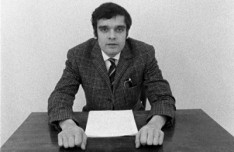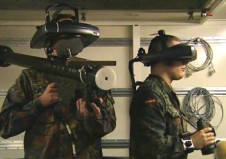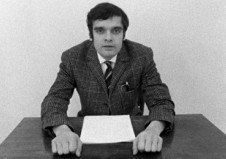Wie man sieht (As You See) – In memory of filmmaker Harun Farocki

Harun Farocki in Nicht löschbares Feuer (Inextinguishable Fire)
The Goethe-Institut Los Angeles and Los Angeles Filmforum present
Wie man sieht (As You See)
In memory of filmmaker Harun Farocki
Wednesday January 21, 2015, 7:00 pm
Screening 2: Erkennen und Verfolgen (War at a Distance) and Nicht löschbares Feuer (Inextinguishable Fire)
Film Series
Wednesdays, January 14th through March 4th 2015
Goethe-Institut Los Angeles, 5750 Wilshire Blvd. Suite 100, Los Angeles, CA 90036
German with English subtitles
Free admission, but RSVP needed, by email to rsvp@losangeles.goethe.org or by phone at 323.525.3388
Harun Farocki – the director whose perspicacious cinematic essays analyzed the new media world – died in July 2014. With his radical way of looking at things Farocki strove to endow images with their own form of self-will, to expose their political and cultural coding.
Farocki lived and worked in Berlin as a filmmaker, artist and writer. His essay and observational films question the production and perception of images, decoding film as a medium and examining how audiovisual culture is related to history, politics, technology and war.
His projects have been shown in festivals and solo, group and retrospective exhibitions worldwide at important events and international institutions, including the 2010 São Paulo Biennial, Documenta X and XXII in Kassel, Tate Modern in London, MACBA in Barcelona, Museum Ludwig in Cologne and the Jeu de Paume in Paris.
All films in this series are in German with English Subtitles, unless otherwise noted.
For more event information: info@losangeles.goethe.org, or +1 323 5253388
Tickets: Free, but please RSVP due to limited seating, by email to rsvp@losangeles.goethe.org or by phone at 323.525.3388
$1 validated parking (for events only) on weekdays after 6:00 pm and all day on weekends in the Wilshire Courtyard West underground garage-P1.
Special Thanks to Daniel Chaffey of the Goethe-Institut Los Angeles and Lucas Quigley for organizing this series.

Erkennen und Verfolgen (War at a Distance)
Erkennen und Verfolgen (War at a Distance)
2003, 58 min. color and b/w. German with English subtitles, Digital.
In 1991, when images of the Gulf War flooded the international media, it was virtually impossible to distinguish between real pictures and those generated on computer. This loss of bearings was to change forever our way of deciphering what we see. The image is no longer used only as testimony, but also as an indispensable link in a process of production and destruction. This is the central premise of "War at a Distance", which continues the deconstruction of claims to visual objectivity Harun Farocki developed in his earlier work. With the help of archival and original material, Farocki sets out in effect to define the relationship between military strategy and industrial production and sheds light on how the technology of war finds applications in everyday life. (Antje Ehmann)

Nicht löschbares Feuer (Inextinguishable Fire)
Nicht löschbares Feuer (Inextinguishable Fire)
1969, 25 min., B/W, German with English subtitles, Digital.
"When we show you pictures of napalm victims, you'll shut your eyes. You'll close your eyes to the pictures. Then you'll close them to the memory. And then you'll close your eyes to the facts." These words are spoken at the beginning of an agitprop film that can be viewed as a unique and remarkable development. Farocki refrains from making any sort of emotional appeal. His point of departure is the following: "When napalm is burning, it is too late to extinguish it. You have to fight napalm where it is produced: in the factories." Resolutely, Farocki names names: the manufacturer is Dow Chemical, based in Midland, Michigan in the United States. Against backdrops suggesting the laboratories and offices of this corporation, the film then proceeds to educate us with an austerity reminiscent of Jean Marie Straub. Farocki's development unfolds: "(1) A major corporation is like a construction set. It can be used to put together the whole world. (2) Because of the growing division of labor, many people no longer recognize the role they play in producing mass destruction. (3) That which is manufactured in the end is the product of the workers, students, and engineers." This last thesis is illustrated with an alarmingly clear image. The same actor, each time at a washroom sink, introduces himself as a worker, a student, an engineer. As an engineer, carrying a vacuum cleaner in one hand and a machine gun in the other, he says, "I am an engineer and I work for an electrical corporation. The workers think we produce vacuum cleaners. The students think we make machine guns. This vacuum cleaner can be a valuable weapon. This machine gun can be a useful household appliance. What we produce is the product of the workers, students, and engineers." (Hans Stempel, Frankfurter Rundschau, June 14, 1969)
